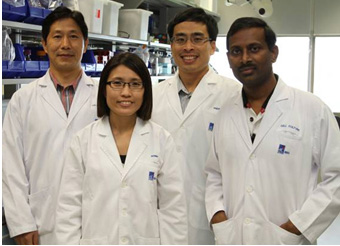The push towards growing organs for transplantation has received a boost from the latest discovery by the Institute of Bioengineering and Nanotechnology (IBN), the world's first bioengineering and nanotechnology research institute. Researchers from IBN have shown that human embryonic stem cells (hESCs) can be transformed into heart cells using a 'decellularized' heart as a scaffold.
Every day, 15 people die from heart disease in Singapore, which accounted for 31.6% of all deaths in 2009.1 Worldwide, the number of severe heart failure patients waiting for transplant far exceeds the number of available donor hearts. The severe shortage of available donor hearts necessitates the development of other options for heart replacement. Now, with IBN's research breakthrough, we are one step closer to growing a new replacement heart from human embryonic stem cells.
 The IBN research team comprising Dr Shujun Gao, Serina Ng, Dr Andrew Wan and Dr Karthikeyan Narayanan (from left to right).
The IBN research team comprising Dr Shujun Gao, Serina Ng, Dr Andrew Wan and Dr Karthikeyan Narayanan (from left to right).
Every organ in the human body has a scaffold or a structure, which provides it with its shape, and within this scaffold are many different types of cells with different functions. Tissue engineering aims to create the organ scaffold - either through the use of synthetic materials such as polymers, or through decellularization, which uses the whole organ as a scaffold after removing its cells.
Decellularization is ideal for tissue regeneration because it preserves the three-dimensional structure of the organ and the extracellular matrix (ECM) - the framework between the cells - that are complex and difficult to mimic. While current methods use specific ECM proteins to transform stem cells into a particular cell type, scientists have found it difficult to imitate the natural ECM.
Using the decellularization approach, a team of researchers led by Dr Andrew Wan, IBN Team Leader and Principal Research Scientist and Dr Karthikeyan Narayanan, Senior Research Scientist and Project Leader, removed the cells from the heart of a mouse and implanted the empty heart scaffold with hESCs to observe if these cells could attach to the scaffold and develop into heart cells. After 14 days, the cells developed into two different types of cells found in the heart: cardiac marker expressing cells and endothelial or blood vessel cells.
The cell-laden scaffold was then implanted back into the mouse where it was observed to develop visible blood vessels. The formation of blood vessels in the scaffold is critical for the transport of nutrients and oxygen to the heart, and has posed a major challenge in tissue engineering.
Dr Wan explained, "By exploiting the intact scaffold of a heart, we have directed the differentiation of human embryonic stem cells into cardiac cells. This study is the first proof-of-concept that addressed the complexity of obtaining different cell types in a scaffold using stem cells. The positive results we have derived encourage us to take this one step further, to achieve functional cardiac cells, and bring whole organ regeneration to the next level."
Professor Jackie Ying, IBN Executive Director, added, "IBN's Cell and Tissue Engineering research is actively developing bioartificial organs using a combination of stem cell technology and biocompatible materials as alternative treatments for organ failures."
Stem cells are an attractive cell source for seeding decellularized organs. Besides hESCs, the team also used progenitor cells derived from the hESCs, which are found in a subset of tissues including heart tissues, to see if the two cell types would regenerate differently. The findings revealed that both stem cell types developed different types of cardiac marker expressing cells and the progenitor cells exhibited the same gene expression pattern as cells in a beating heart.
Published recently in a leading peer-reviewed journal, Biomaterials, this new finding could pave the way to the development of a bioartificial heart, and realize the decellularized organ approach for organ transplantation. If successful, xenogeneic organs - animal organs seeded with human stem cells - could then be explored as a feasible alternative for regenerative medicine.
Source:
Singapore Heart Foundation